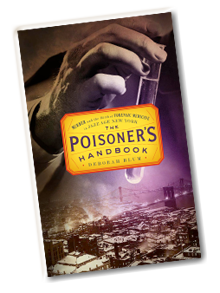UW professor’s best-selling book adapted for PBS documentary on poisoning
Once upon a time in America if you wanted to get away with murder, poison was the way to go.
At the turn of the 20th century, patent medicines, health elixirs, and consumer products of all manner were laden with toxins as their active ingredients, making poison prevalent and handy. Agents like radioactive thallium and radium, morphine derivatives, cyanide and arsenic were as close as your medicine cabinet, corner pharmacy or hardware store, no questions asked.

Deborah Blum
The unfettered industrialization of the day, of course, brought America into much more intimate contact with poisons of all manner, and it was not lost on evildoers that poison was both effective and difficult to detect and link to capital crime.
Enter Charles Norris, New York City’s first scientifically trained medical examiner, and his chief toxicologist Alexander Gettler, who in 1918 began to devise the forensic methods that would expose crime and demystify such plagues as the rampant alcohol poisonings of the prohibition era.
Norris, Gettler and the poisons of their day are the key protagonists of UW–Madison journalism Professor Deborah Blum’s best-selling “The Poisoner’s Handbook.” On Tuesday, Jan. 7 (7 p.m. PBS), Blum’s book comes to the small screen in all its toxic glory in a two-hour “American Experience” historical documentary.
“The film is a mix of dramatic re-creation, original film clips, and photos and documents and interviews,” explains Blum. “The parts I’ve seen in advance have been great, catching that same 1920s murder-mystery feel that I tried to create in the book.”
Blum’s yarn of chemical toxins and the people who used or were affected by them has all of the human foibles – greed, lust, hubris, ignorance, naked political ambition, and other pathologies – that infuse a good story.

Beyond sheer entertainment, however, is a lesson of science and society. And Blum, a crack science journalist outside the classroom, is careful to bring the lesson home. Like all good science writers, she gives us the context and shows why the science matters. The work of Norris and Gettler ultimately underpinned government regulation of chemicals in the workplace and in consumer products and laid the foundation for the Food and Drug Administration, the federal agency that oversees food and chemical safety in the market.
“It’s a thrill to see a book turned into a film,” says Blum of the documentary, part of which was shot in Prague to mimic 1920s New York. “The actors look amazingly like the real-life heroes of my book. And as an author, I’m delighted that they’ve kept the title!”




